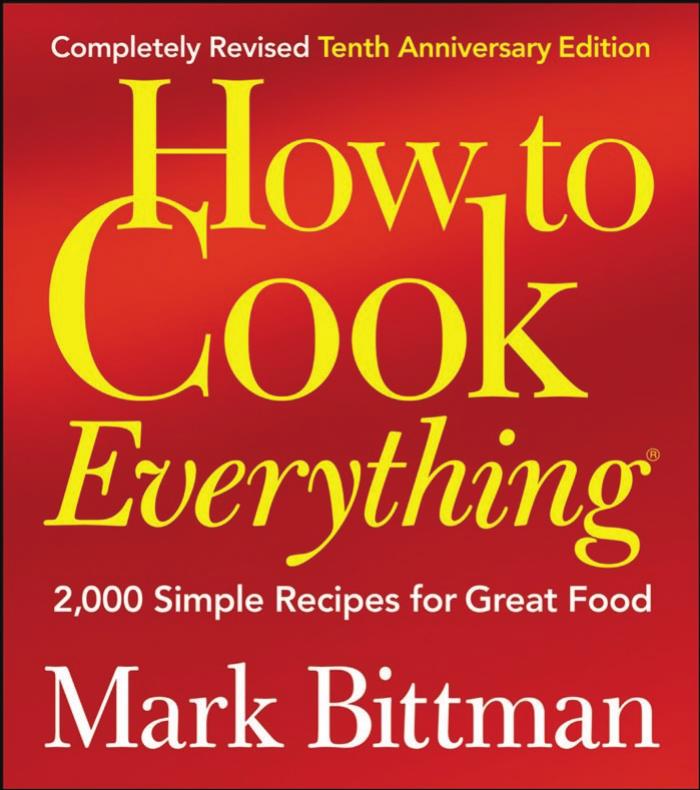How to Cook Everything (Completely Revised 10th Anniversary Edition), Completely Revised 10th Anniversary Edition: 2,000 Simple Recipes for Great Food by Mark Bittman

Author:Mark Bittman
Language: eng
Format: mobi, epub, pdf
Tags: ISBN-13: 9780764578656, Wiley
Published: 2011-12-11T20:13:00+00:00
16162_Bittman_5p_c09.f.qxp 8/22/08 11:01 AM Page 537
ble the dish up to several hours before baking; let the
components cool a bit, cover well, and refrigerate. Transfer it directly to the oven from the fridge, adding about 10 minutes to the baking time.)
Creamy Baked Noodles with Mushrooms and Cheese.
For a meatier texture, replace the eggplant with any
fresh mushrooms.
To make the pasta by hand, first make a well in the mound of The Basics of Fresh Pasta
flour and break the eggs into it.
It’s likely that noodles were first cooked in China, Italy, or both; at the end of the day it doesn’t matter much. A paste (English for “pasta”) made of flour and liquid—
whether water, oil, eggs, or a combination—was a simple
enough step in the development of cuisine, and cutting
the paste into strands . . . well, we all know how much
fun making clay ropes is. It’s a bit of work—at least the first time you do it—but you will be stunned at what a
lovely thing you’ve produced. Making pasta elicits a sense of accomplishment, as if you’ve created something terTo knead the dough, use the heel of your hand to push into rific. And you have.
the middle of the dough, fold the dough over, rotate it 90
Two basic doughs—one flour and water, the other
degrees, and push into it again.
flour and egg—form the backbone of all fresh noodles:
pasta, ravioli, gnocchi, dumplings, even spaetzle. The differences among these boil down to the shape or use of
dough and the filling, if any. This first section focuses on middle of the flour. Put your eggs or liquids into this
Italian-style pastas but includes variations to make fresh well, then use a fork or wooden spoon to incorporate the Asian-style noodles too, with recipes that range from rich flour. Once a dough begins to form, use your hands to
and eggy to eggless to bright and herby; they’re all pretty fully incorporate the remaining flour. It’ll be messy at much classic in both noodle-making traditions.
first but should start to come together within a couple of minutes. It’s at this point, when the dough is still shaggy, that you want to add more liquid (water or olive oil) or Basic Pasta-Making Techniques
flour in small amounts. You’ll know which to add by the
You can make fresh pasta by kneading it to a firm,
look and feel of the dough; if it’s mushy and sticking to smooth dough, but it’s far easier to start the dough in a your hands, you need more flour; if it’s not coming
food processor, then finish it with a pasta-rolling
together and separated into dried-out-looking pieces,
machine.
you need more liquid.
For literally handmade pasta, pile your flour on a
From this point it’s a matter of kneading, and
smooth, clean work surface (for Fresh Egg Pasta) or in a although it takes some energy, it’s much faster and easier large bowl (for Eggless Pasta) and create a hollow in the than kneading bread dough. Form the dough into a ball,
PASTA, NOODLES, AND DUMPLINGS
537
Download
How to Cook Everything (Completely Revised 10th Anniversary Edition), Completely Revised 10th Anniversary Edition: 2,000 Simple Recipes for Great Food by Mark Bittman.epub
How to Cook Everything (Completely Revised 10th Anniversary Edition), Completely Revised 10th Anniversary Edition: 2,000 Simple Recipes for Great Food by Mark Bittman.pdf
This site does not store any files on its server. We only index and link to content provided by other sites. Please contact the content providers to delete copyright contents if any and email us, we'll remove relevant links or contents immediately.
Whiskies (Collins Gem) by dominic roskrow(45090)
101 Whiskies to Try Before You Die by Ian Buxton(44818)
World's Best Whiskies by Dominic Roskrow(44754)
Whiskies Galore by Ian Buxton(41888)
The Fast Metabolism Diet Cookbook by Haylie Pomroy(21069)
Chic & Unique Celebration Cakes by Zoe Clark(19963)
Craft Beer for the Homebrewer by Michael Agnew(18146)
The Bone Broth Miracle: How an Ancient Remedy Can Improve Health, Fight Aging, and Boost Beauty by Ariane Resnick(16558)
For the Love of Europe by Rick Steves(13136)
Tools of Titans by Timothy Ferriss(8230)
A Court of Wings and Ruin by Sarah J. Maas(7654)
How to Be a Bawse: A Guide to Conquering Life by Lilly Singh(7397)
The Institute by Stephen King(6948)
Chowders and Soups by Liz Feltham(6924)
Cravings: Recipes for All the Food You Want to Eat by Chrissy Teigen & Adeena Sussman(6750)
Wiseguy by Nicholas Pileggi(5675)
The Last Wish (The Witcher Book 1) by Andrzej Sapkowski(5396)
Spare by Prince Harry The Duke of Sussex(5078)
Room 212 by Kate Stewart(5041)
